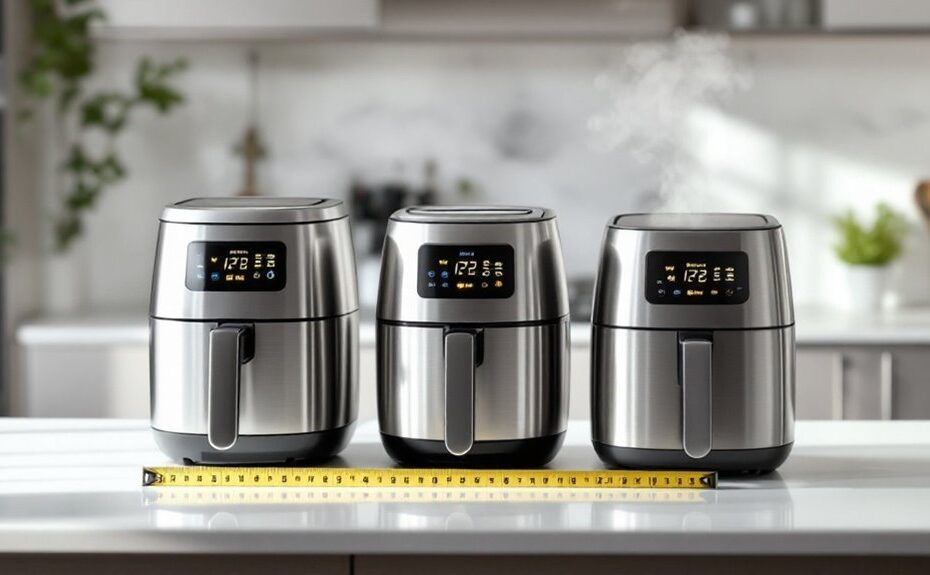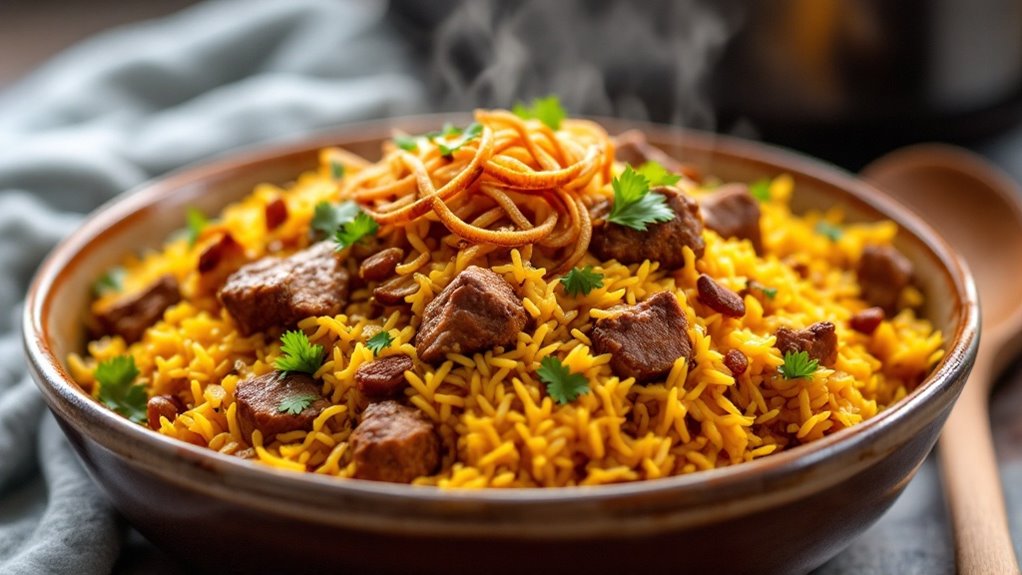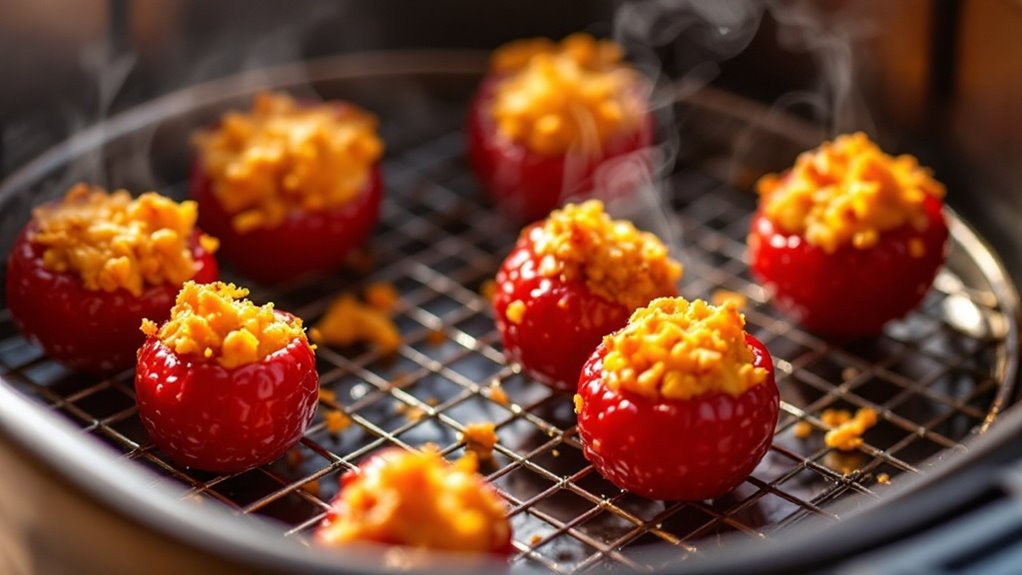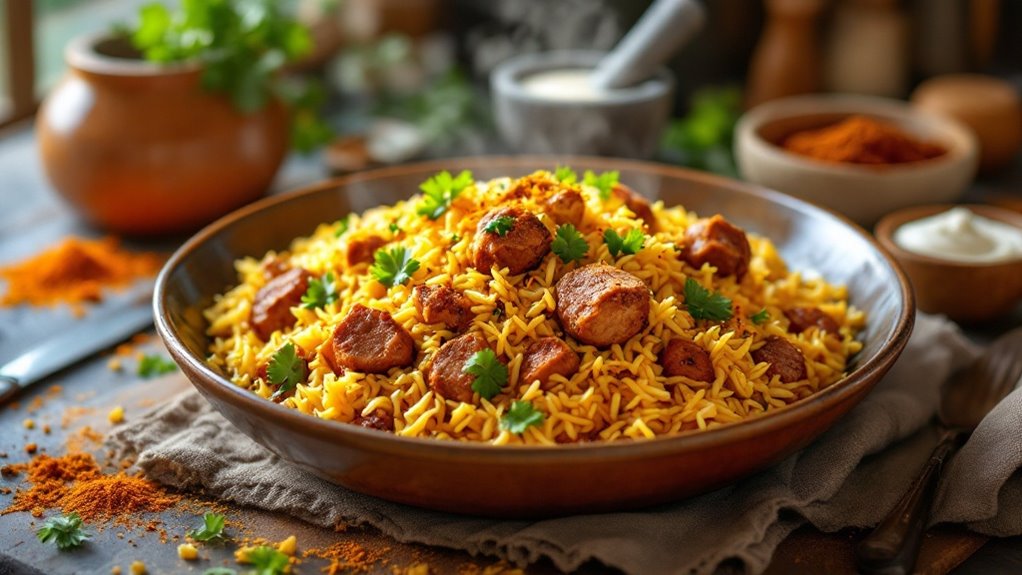When choosing an air fryer, wattage isn't just a number—it's the heartbeat of its performance. You'll find that higher wattage models cook faster and handle larger meals, but they also guzzle more energy. On the other hand, lower wattage units are quieter and more efficient, though they might test your patience with longer cooking times. The real question is: how do you balance speed, efficiency, and capacity to match your needs? Understanding these trade-offs can help you make a smarter choice, but there's more to uncover about how wattage shapes your cooking experience.
Key Takeaways
- Higher wattage (1,500-1,800W) air fryers cook faster and handle larger batches, while lower wattage (800-1,200W) models are quieter and more energy-efficient.
- Match wattage to cooking needs: higher wattage for speed and versatility, lower wattage for smaller portions or energy-conscious users.
- Higher wattage models preheat faster and reduce cooking times, ideal for frequent or high-volume cooking.
- Lower wattage units may require longer cooking times and struggle with larger or denser foods.
- Compare wattage relative to basket capacity to ensure even cooking and avoid mismatched performance.
Understanding Wattage in Air Fryers
When choosing an air fryer, wattage plays a critical role in determining its performance, as it directly impacts cooking speed and efficiency. Higher wattage models, typically ranging from 1,500 to 1,800 watts, deliver faster heat circulation, but they also consume more energy. Lower wattage units, around 800 to 1,200 watts, are more energy-efficient but may take longer to cook. Always check wattage safety tips, such as ensuring your outlet can handle the appliance's power requirements to avoid overheating or tripping circuits. Additionally, consider wattage noise levels—higher wattage air fryers often produce more fan noise due to increased airflow. Compare models within the same wattage range to assess features like temperature control and build quality, ensuring you balance power with practicality.
How Wattage Affects Cooking Speed
Higher wattage air fryers cook faster because they generate more heat, reducing cooking times considerably. Lower wattage models take longer to reach ideal temperatures, resulting in slower cooking and potentially uneven results. The wattage directly impacts heat distribution, with higher-powered units maintaining consistent temperatures for quicker, more efficient cooking.
Higher Wattage, Faster Cooking
Air fryers with higher wattage deliver faster cooking times because they generate more heat and circulate it more efficiently. When you choose a model with 1,700 watts or more, you'll notice quicker preheating and reduced cooking durations compared to lower-wattage units. This wattage efficiency guarantees even heat distribution, which is essential for achieving crispy textures without overcooking. Higher wattage also enhances wattage versatility, allowing you to handle a wider range of foods, from frozen items to dense vegetables, with consistent results. For example, a 1,800-watt air fryer can cook fries in 12 minutes, while a 1,200-watt model might take 18 minutes. The increased power directly impacts performance, making high-wattage models ideal for those prioritizing speed and precision in their cooking.
Lower Wattage, Slower Results
While higher wattage air fryers excel in speed, lower-wattage models, typically ranging from 800 to 1,400 watts, require more time to achieve similar results. These units generate less heat, so you'll need to extend cooking times by 10-20% compared to higher-wattage counterparts. However, they often offer better energy efficiency, consuming less power over longer periods. Cooking consistency can still be achieved, but you'll need to monitor food closely and adjust settings to prevent undercooking. Lower-wattage air fryers are ideal for smaller households or those prioritizing energy savings over speed. While they may not crisp food as quickly, they can still deliver quality results with patience and proper technique. Consider your cooking needs and time constraints when evaluating these models.
Wattage Impacts Heat Distribution
Because wattage directly influences the heating element's power, it plays a critical role in how quickly and evenly an air fryer distributes heat. Higher-wattage models (1500W or more) generate intense heat faster, ensuring better heat consistency across the cooking chamber. This results in faster cooking times and more uniform browning. Lower-wattage units (below 1200W) may struggle to maintain consistent temperatures, leading to unevenly cooked food. When comparing models, prioritize wattage alongside temperature control features. Advanced air fryers with precise thermostats and adjustable wattage settings offer superior heat distribution, even at lower power levels. For example, a 1700W air fryer with digital controls outperforms a 1400W model with manual dials in maintaining heat consistency. Always consider wattage as a key factor for efficient heat distribution and cooking performance.
Energy Consumption and Wattage
When choosing an air fryer, understanding its wattage is essential since it directly impacts energy consumption and cooking performance. Higher-wattage models, typically ranging from 1,500 to 1,800 watts, consume more power but heat up faster and maintain consistent temperatures, which can reduce cooking times. Lower-wattage units, around 800 to 1,200 watts, use less energy but may take longer to cook food evenly. To assess energy efficiency, compare the power consumption of different models relative to their cooking speed and results. A 1,500-watt air fryer might use more electricity per hour than a 1,000-watt one, but if it cooks food in half the time, it could be more efficient overall. Always check the wattage and balance it with your energy usage preferences to optimize performance and cost-effectiveness.
Wattage and Cooking Capacity
Higher wattage air fryers heat up faster and cook food more efficiently, reducing overall cooking time. However, cooking capacity, measured in quarts, determines how much food you can prepare in a single batch, impacting convenience for larger meals. Balancing wattage and capacity guarantees you choose a model that meets both speed and volume needs for your cooking habits.
Wattage Affects Cooking Speed
Air fryers with higher wattage generally cook food faster due to their ability to generate more heat in a shorter time. When comparing models, you'll notice wattage variability directly impacts cooking speed—units with 1,700W or more can crisp fries or roast vegetables quicker than 1,200W models. Higher wattage guarantees consistent heat distribution, reducing the likelihood of undercooked or unevenly cooked food. However, cooking consistency also depends on the air fryer's design and airflow efficiency. Lower-wattage models may require longer preheating and extended cooking times, which can affect texture and moisture retention. If speed is a priority, opt for a higher-wattage air fryer, but make sure it aligns with your energy consumption preferences. Balancing wattage with cooking needs guarantees peak performance without compromising on quality.
Capacity Determines Batch Size
The wattage of an air fryer not only influences cooking speed but also plays a role in how effectively it handles larger batch sizes. Higher-wattage models, typically ranging from 1,500 to 1,800 watts, often pair with larger capacities, enabling you to cook more food at once without sacrificing cooking efficiency. For example, a 1,700-watt air fryer with a 6-quart capacity can handle a full batch of fries or chicken wings evenly, while a lower-wattage unit might struggle with the same batch size, leading to unevenly cooked food. When comparing models, consider how the wattage aligns with the basket size. A mismatch can result in longer cook times or the need to cook in multiple batches, reducing overall efficiency. Always match wattage to your typical batch size for ideal performance.
Comparing High vs. Low Wattage Models
When choosing between high and low wattage air fryers, it's important to evaluate how power impacts performance. High-wattage models (1,500W or more) heat up faster and maintain consistent temperatures, but they consume more energy and may require wattage safety tips, such as ensuring your outlet can handle the load. Low-wattage units (below 1,200W) are more energy-efficient and quieter, with lower wattage noise levels, but they may take longer to cook food evenly. High-wattage air fryers often have more robust fans, which can increase noise, while low-wattage models operate more quietly. Consider your kitchen's electrical capacity and noise tolerance when deciding. High-wattage models suit frequent, high-volume cooking, while low-wattage options are ideal for smaller households or energy-conscious users.
Wattage and Cooking Performance
Wattage directly influences how efficiently an air fryer cooks food, with higher wattage models typically delivering faster preheating and more consistent heat distribution. When comparing wattage efficiency, a 1,700-watt air fryer will crisp foods quicker than a 1,200-watt model, reducing cooking times noticeably. Higher wattage also enhances wattage versatility, allowing you to handle larger batches or denser foods like frozen fries or chicken wings without compromising texture. Lower wattage units may struggle with uneven cooking or longer wait times, especially when preparing multiple servings. However, wattage isn't the sole factor—design and airflow also impact performance. For ideal results, match wattage to your cooking needs: higher for speed and versatility, lower for smaller portions or energy-conscious use. Always prioritize wattage efficiency for consistent, high-quality results.
Wattage and Price Considerations
Higher-wattage air fryers often come with a steeper price tag, but they're worth considering if you prioritize faster cooking times and better performance with larger or denser foods. When evaluating wattage pricing, balance upfront costs with long-term cost efficiency. A 1,700-watt model may cost more than a 1,200-watt one, but it can reduce cooking time and energy use per meal, potentially saving you money over time. Lower-wattage units are cheaper initially but may struggle with consistent results or require longer cooking cycles, increasing energy consumption. Compare wattage pricing across brands to identify value-for-money options. High-wattage models often include advanced features like precise temperature control, which can justify the higher cost. Assess your budget and cooking habits to determine if the investment aligns with your needs.
Choosing the Right Wattage for Your Needs
To determine the ideal wattage for your air fryer, start by evaluating the types of meals you typically prepare and the size of your household. For smaller households or light cooking needs, a 1,000-1,400W model offers sufficient wattage efficiency for reheating or preparing snacks. Larger families or frequent cooks benefit from 1,700-2,000W units, which provide greater wattage versatility for handling larger portions or multi-ingredient dishes. Higher wattage guarantees faster cooking times and consistent results, but it also increases energy consumption. If you prioritize speed and performance, opt for a higher-wattage model. Conversely, if energy efficiency is a concern, a mid-range wattage air fryer balances power and consumption. Always cross-check wattage with basket capacity to confirm the appliance meets your cooking demands without unnecessary energy use.
Disclosure: As an Amazon Associate, I earn from qualifying purchases.



